My Buddhist temple stay with monks in Mount Koya, Japan! Booking a Koyasan guesthouse, Okunoin graveyard.

As the cherry blossoms bloom for sakura season, I’m thinking back to my days in Japan. I did something very different from my usual trips: I escaped for a few days to a Buddhist temple retreat in Koyasan!
Several of my friends have stayed with the Japanese monks of Mount Kōya (in the mountains north of Osaka), and raved about the peaceful experience. Since I was traveling with my unlimited Japan Rail Pass, it was the perfect opportunity to do a spiritual pilgrimage.

Mt. Kōya was first settled in the year 819 by the monk Kūkai, founder of the Shingon sect of Japanese Buddhism. He discovered this mystical location high in the mountain peaks, and made it the center for his monastic headquarters.

Since then, both monks and laypeople have come to Koyasan to study and practice Esoteric Buddhism. Most come for a 1-3 night stay, so that they can experience living in a temple with Buddhist monks. (I stayed two nights, which is a good amount of time to explore Mount Koya’s attractions.)
I hope this guide to Mount Koya gives you a sense of what it’s like to spend a few days in this spiritual village. You can see more about my entire J Rail Pass journey in the video above, or here on YouTube.

How to get to Mount Koya by train: I recommend getting a JR Rail Pass like I did. The pass lets you ride the rails throughout the country for a week or longer; it includes JR and bullet trans, busses and some ferries.
Most people come to Koyasan from Kyoto or Osaka. From Osaka, it’s only a 1.5 to 2 hour train ride: take the Nankai line from Namba or Shin-Imamiya Stations, and get off at Gokurakubashi (you may need to transfer at Hashimoto station). Then, it’s a 5 minute cable car up the scenic mountains, and a short bus ride into the town where the temple-stays are located.

How to book a room at a temple stay: These Buddhist guesthouses (shukubo) are run independently by the monks, and most don’t even have websites.
Foreigners can visit the Koyasan Shukubo Association website, and fill out the form to make a reservation request (your travel dates, price range, etc). You’ll quickly receive an email reply in English, with a booking that you can confirm, and information such as maps. There’s no fee for this tourist service; you simply pay the guesthouse directly in cash upon check-out.

I stayed at Hoon-in, a simple yet comfortable and authentic shukubo. I was greeted by a young Buddhist monk, who spoke English and showed me to my room (traditional-style Japanese accommodations with tatami floor mats, sliding doors, and futon mattresses).

The monks serve the guests a vegetarian breakfast and dinner every day, and these meals are included in the price of the stay (about 10,800 yen per person, per night). I enjoyed gathering in this long dining hall and sitting cross-legged on the mat.

Everyone receives a tray of delicacies — it’s a joy to open up the lids and see what’s inside! The cuisine is seasonal and vegetarian, and there are a variety of small dishes: tofu, soups, pickled vegetables, tempura, miso eggplant, rice and fruit. You can also order a small bottle of hot or cold sake to round out your meal.
I was impressed with everything I ate at Hoon-in. The plant-based fare is fresh, delicately seasoned and beautifully presented.
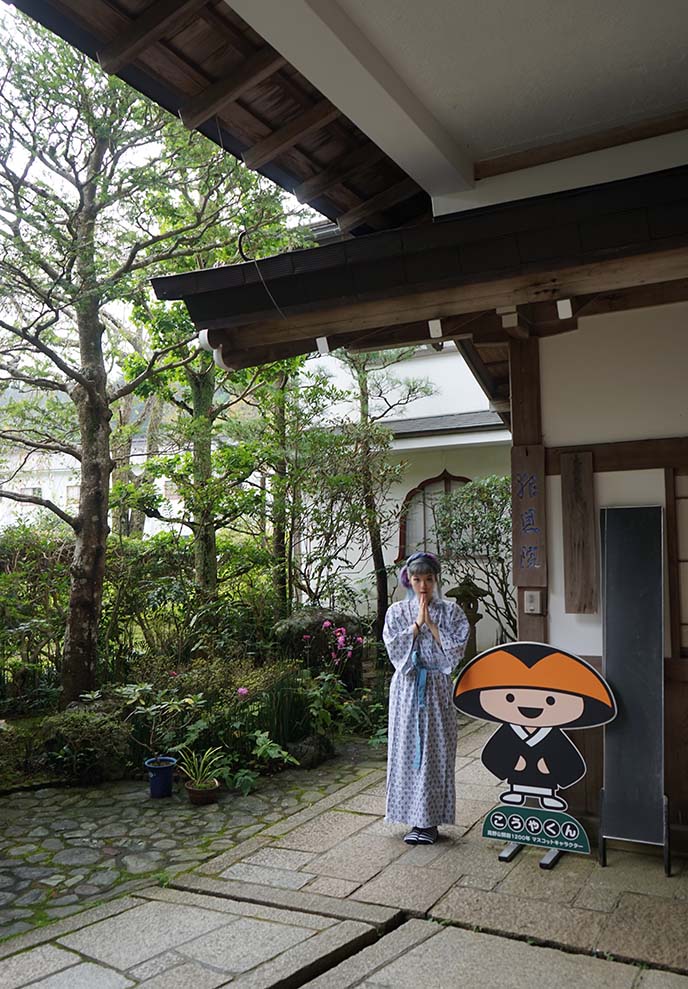
I loved participating in the simple day-to-day life of the temple. At the lush entrance, you take off your shoes and wear socks or slippers. Each guest gets a robe to wear, and can soak in a large Japanese-style bathtub.
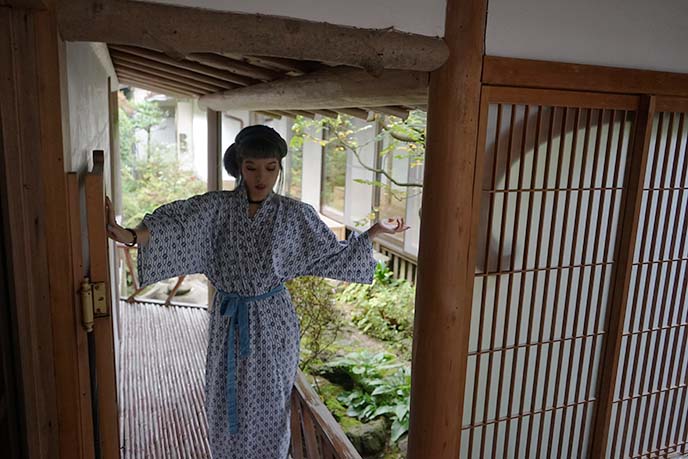
Although you get to feel as if you’re in ancient Japan, the guesthouse has modern amenities such as free and fast WiFi. There’s even a convenience store and ATM machine next door, and you can easily walk to cafes, shops and more.

There are no “mandatory activities” or programs at Mt Koya’s shukubos. However, the guests are invited to wake up at 6am to see the resident Shingon monks chant sutras. I’m not a morning person, but this is well worth getting out of bed for.

The monks’ chanting consists of low, guttural, repetitive verses, expressed in the same or different tones. (You can hear the Buddhist chants in my travel video.)
This ritual is as form of meditation that joins the body, speech and mind. It’s a feast for the senses: the monks sit beneath gold relics, light incense and candles, arrange offerings on the alter, and ring a bell or gong. It’s a powerful and uplifting effect that I hope you can experience in-person.

For the rest of the day, you can walk around and visit the various temples, ancient gates, Tokugawa mausoleum, and other sites.
Of course, the town has a kawaii mascot: “Koya-kun!” The cute character is supposed to be little monk in a “kasa” bowl-shaped hat… but doesn’t he remind of Toad the mushroom-head, from Super Mario Brothers?

I encourage you to wander around at a leisurely pace, rather than making specific plans. There’s no better place than Koya to practice mindfulness and being in the moment.

Visiting Okunoin graveyard is an absolute must. It’s best to come during the morning, when the lighting conditions are ideal and there aren’t too many other visitors.
At the Ichinohashi Bridge (the traditional entrance to the cemetery), visitors bow and pay respect to Kobo Daishi (the posthumous honorific name for Kukui).

I loved exploring Okunoin, filled with 200,000 ancient graves. This immense, forested cemetery is the largest in Japan, and home to the mausoleum of Kukai.

I came across many small Buddha statues, adorned with red bibs and hats. They represent the Bodhisattva Jizo, who protects travelers, women and children.
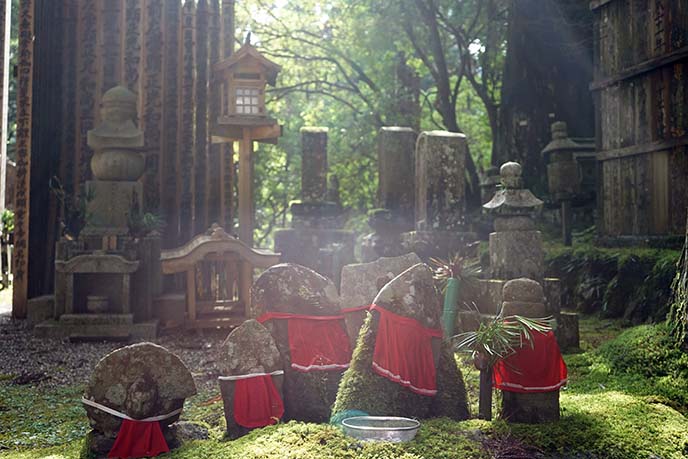
The gravestones are surrounded by a lush canopy of towering cedar trees. The inner sanctuary contains the resting grounds of several famous Japanese, including the samurai ruler Toyotomi Hideyoshi, and a memorial to the soldiers who died in the Pacific War.
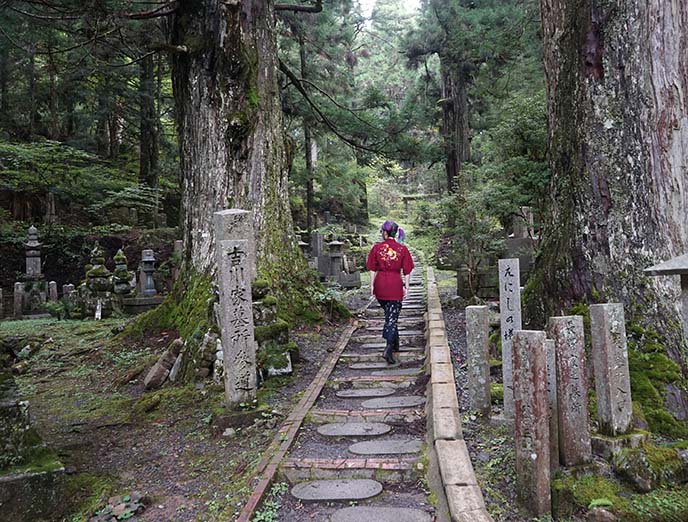
Okunoin cemetery has an otherworldly feeling. I felt as if I were surrounded by ancient Buddhist spirits.

Some of the graves are over 1000 years old, and covered in layers of moss. No wonder Koya-san was declared a UNESCO protected site in 2004.

The path through the cemetery spans two kilometers. Along the way, you’ll find lots of interesting sculptures and gates, which cast shadows under the morning rays.

Many visitors leave flowers and offerings in front of the tombstones.

The buried Buddhist monks are not dead according to legend, but meditating and waiting.
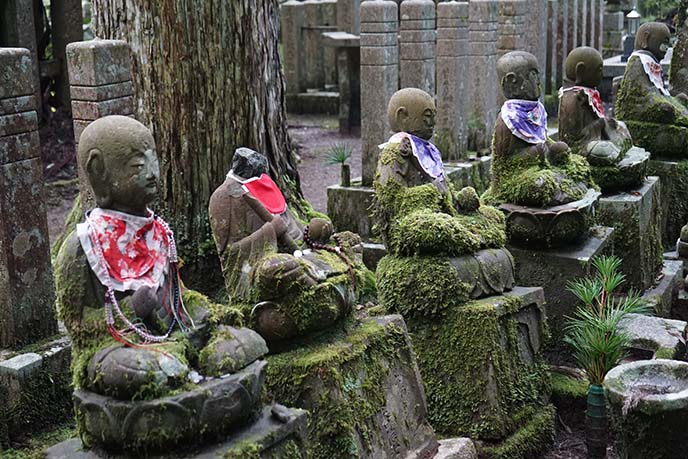
You’ll notice that many of the little Buddha statues are wearing colorful red or purple bibs. Often, people who lost children tie these cloths around Jizo Bosatsu, since he is believed to protect children in the afterlife.
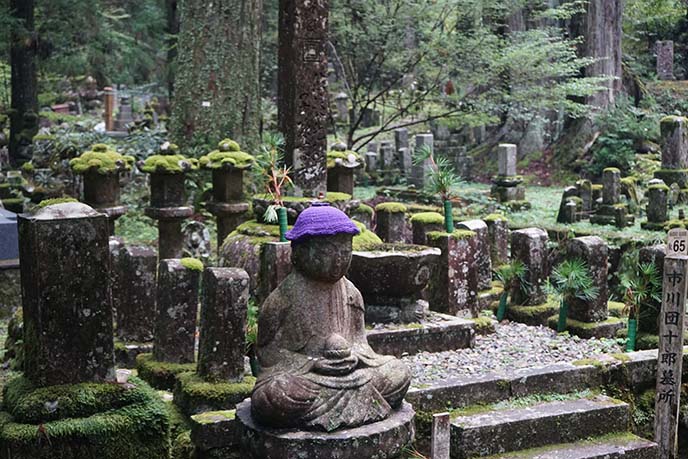
These lovingly handmade hats and accessories keep the Bodhisattvas warm.

Doesn’t it seem like these stone statues are bursting with personality? I half expected this little guy to stand up and bow, as if were a character out of Totoro.

At night, Okunoin cemetery is lit up by long rows of stone lanterns for a spooky atmosphere.

I was fortunate to be in Mount Koya during an October festival for the spirits. These yellow-robed Buddhist monks walked single-file through the graveyard, followed by the head monk under a red umbrella.

Everyone followed the Shingon Buddhist procession to the main temple of Okunoin. The monks slipped off their shoes to enter the inner sanctuary, which was glowing with lanterns and golden artefacts.
From behind the barrier, we watched the monks march in a circle and recite chants, while incense filled the air. A powerful and uplifting ritual — I’m fortunate to have witnessed it.
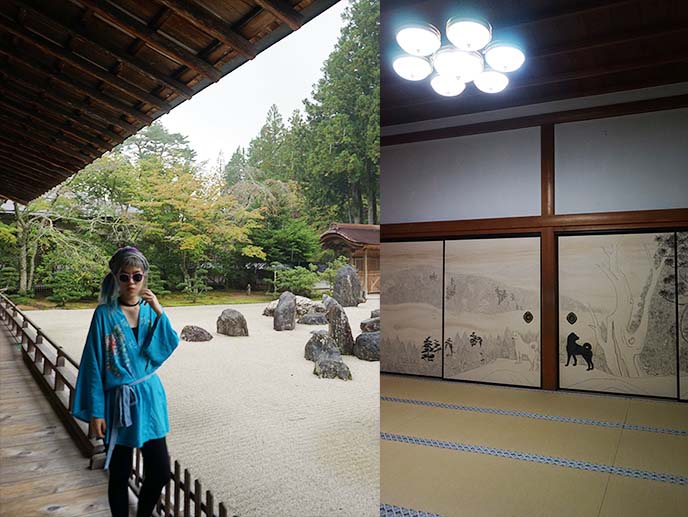
The next day, I continued to take in the sights around Koyasan. I’m standing inside Kongobuji temple, the head temple of Koya’s Shingon Buddhist sect. It was built in 1593 by Toyotomi Hideyoshi upon the death of his mother.
Inside Kongōbu-ji, you’ll find Banryūtei, the largest rock garden in Japan. The inner rooms are beautifully decorated with sliding doors (fusuma) that depict cranes, animals and ancient landscapes.

The Garan (Koyasan’s central temple complex) features a Kondo Hall, and the eye-catching Konpon Daitō pagoda.
The interior holds a statue of the Cosmic Buddha (Dainichi Nyorai) surrounded by art, which comes together to form a three-dimensional mandala.

I snapped a photo of a monk bowing in front of Sanmaido Hall. This is supposedly where Nichiren (Buddhist founder of the Nichiren school) debated other monks.

I discovered a pond with lotus leaves, under a red arching bridge… Koyasan, you’re magic.

There are many shukubo (guesthouse) to choose from, which all offer the temple stay experience. This one had a perfectly raked sand garden.

Do you see Koya-kun peeking out from the bushes? (I’m wearing vintage Japanese robes.)
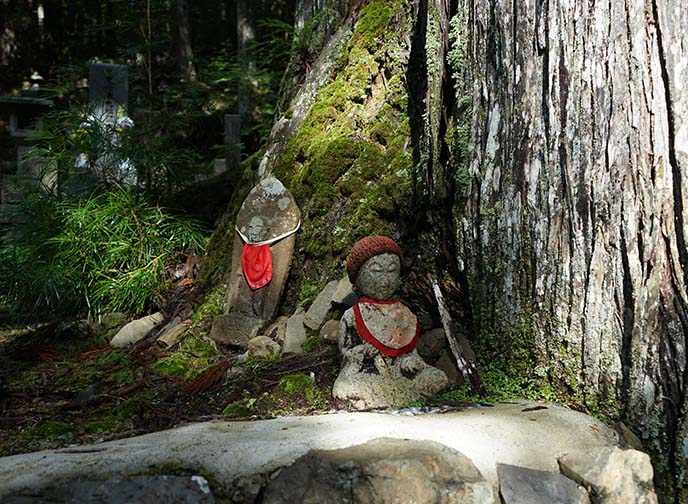
I loved immersing myself into the spiritual culture of Koyasan. I hope you’ll take the cable-car up to these tranquil mountains one day.

Would you do a temple stay in a Japanese Buddhist temple, like I did? For more about Mt. Koya and my Japan trip, enjoy my travel video — and feel free to ask me any questions in the comments.
SHARE & COMMENT

 LA CARMINA
LA CARMINA







24 Comments
this is beautiful
Cheers!
Japan in cherry blossom season <3 <3
Yeahh I miss it.
Wow!!!!!
Whow, how beautiful!
xx
OMG!! You did it. Great photos.
SS
:)
Stunning!
^_^
Always wanted to do this.
Me too.
The graveyard looks like out of a dream..
It felt like it was inhabited by ghosts, in a great way!
You have the most interesting life
loveeeeeeeeeeeeeeeeeeeeeeeee
xoxox
Hi, Great , Very detailed and helpful to me, I just want to ask something regarding morning prayer and Night tour, because i was already booked to a Guesthouse and I would like to Join the Night tour and Morning Prayers? is that possible to just come to a Temple/Shukubu? Thank you in advance :)
Hi! The morning chanting was at our guesthouse, Hoon-in, and I think it was only open to those of us who stayed there (it was upstairs, at 6am or 630am). Can you ask your guest house if they have any chanting / activities? The night-time ritual only happened once a year (or at occasional special events), and it wasn’t a tour – anyone can go at night to see it. I suggest asking your guesthouse if anything special is going on – and you can easily take the bus to Okunoin graveyard!
Such a fantastic experience! So glad we were able to share it with you guys! xx
<3 <3 see you again soon!
Hi I was just wondering what date in October the one time night prayer happened? I am travelling to Japan in Oct and would love to time out visit to mt koya when this happens.
Thank you and great blog :)
Hi! Thanks for the comment :) When I was there, it was Oct 1 – but I don’t know if it would be the same date this year. Maybe when you choose a shukubo, you can ask them if they might know? Have fun!